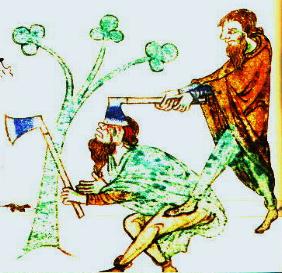The humble hand axe, or tomahawk, is an iconic tool of the
Scots-Irish. It was the multi-tool of
its day, of use around the camp for cutting, splitting wood, to drive stakes,
and also used for personal protection.
It was good in hand to hand close combat and a skilled wielder could throw
it with great precision at ranges from five to twenty yards. While some associate it with the frontier,
its design and use goes back several thousand years.
 |
hand axe in war from a medieval Gaelic manuscript |
 |
| typical frontier tomahawk |
Small hand axes, of the same design and type as used by the
Scots-Irish on the frontier, were in use since prehistoric times in both
Ireland and Scotland. The battle axe was
called a tuagh (said Too-ah) in Gaelic.
There are many hundreds of them in the Irish National Museum. Early ones are in stone and as technology
improved they were made in copper, bronze, iron, and eventually steel. From
their ethnogenesis in Scotland, to their migration to Ireland, and then to the
frontier of the New World, the hand axe, or tomahawk, has remained the one
constant of Scots-Irish material culture. It was the Scots-Irish frontiersman that
introduced the American Indians to the tool.
 |
| deployed American soldier with tomahawk |
No comments:
Post a Comment